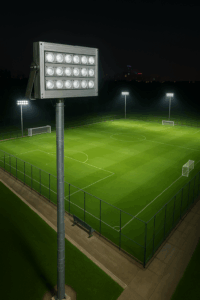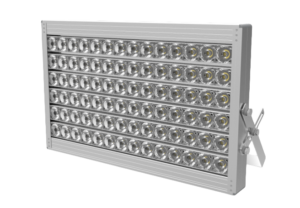Stadium lighting has long been a critical part of American football, enabling gameplay after dark and enhancing the atmosphere for fans both in-stadium and watching at home. But in the last decade, the role of lighting has undergone a major transformation, driven by the adoption of LED (Light Emitting Diode) technology.
Once dominated by metal halide and high-pressure sodium lamps, NFL stadiums now increasingly rely on LED lighting systems. These advanced lighting solutions are not just about energy savings—they’re redefining how games are played, filmed, and experienced. From better player visibility and improved TV broadcasts to dynamic fan engagement and sustainability, LED lighting has revolutionized football under the lights.
Energy Efficiency and Cost Savings
One of the primary drivers behind the widespread adoption of LED lighting is its exceptional energy efficiency. Compared to traditional metal halide fixtures, LED systems use up to 70% less energy to produce the same—if not better—illumination levels. This translates to substantial utility cost savings for stadium operators.
Over the long term, the high initial cost of LED installation is offset by reduced operational expenses. Many NFL franchises report a return on investment (ROI) within 3–5 years due to lower energy bills, fewer lamp replacements, and reduced labor costs.
Instant-On and Dimming Capabilities
Unlike older systems that require 10–15 minutes to warm up, LED fixtures power on instantly. This is vital for professional sports, where delays are costly and inconvenient. LEDs can also be dimmed or brightened on demand, allowing precise control over lighting conditions throughout the game, during halftime shows, or when adapting to changing weather.
Advanced Controls and Smart Integration
LED systems can be paired with advanced control protocols such as DMX512, DALI, and networked smart systems. This gives stadiums the ability to schedule, automate, and modify lighting schemes at a granular level—perfect for complex event setups and televised productions.
Longer Lifespan and Lower Maintenance
Most LED stadium fixtures offer lifespans exceeding 50,000 hours, dramatically reducing the need for maintenance. In high-altitude or difficult-to-access light arrays, this means fewer disruptions and lower maintenance costs.

For athletes performing at the highest level, every detail matters—including lighting. LED lighting delivers a uniform beam pattern, higher lumen output, and superior beam control compared to legacy systems. This results in fewer shadows, better contrast, and increased visual clarity on the field.
High CRI for True Color Accuracy
Color Rendering Index (CRI) is a metric that defines how accurately a light source renders colors. Most metal halide lights range between 60–70 CRI, while LED systems used in NFL stadiums typically exceed 80 or even 90 CRI. This gives players sharper visual cues, helping with ball tracking, depth perception, and reaction time.
Better for Player Safety
Proper lighting reduces the risk of injuries by ensuring players can clearly see the ball, other players, and field boundaries at all times. Uniform lighting minimizes dark spots that can cause hesitation or missteps during high-speed play.
Televised football is a billion-dollar industry, and broadcast lighting standards have evolved dramatically. With the advent of 4K ultra-high-definition (UHD) and high-speed slow-motion replays, lighting must meet strict requirements.
Flicker-Free Performance
Traditional lighting systems often exhibit flicker that becomes visible during slow-motion replays or under high-speed cameras. LED systems, when properly designed, offer flicker-free performance at frame rates up to 1,000 fps, making them ideal for modern broadcasting needs.
Consistent Color Temperature
Most NFL stadiums standardize their LED systems to around 5000K color temperature—a neutral white that aligns well with natural daylight. This enhances visual clarity and consistency across camera angles and ensures that colors appear true on screen, from the team uniforms to the field markings.
No More Color Shifts Over Time
Unlike metal halide lamps that degrade and shift in color over time, LEDs maintain consistent output and color throughout their lifespan, ensuring predictable lighting across seasons.
Today’s fans expect more than just a game—they want an immersive entertainment experience. LED lighting systems are critical to delivering this spectacle, both in-person and on-screen.
Theatrical Lighting Effects
Modern stadium LED systems are often integrated with RGBW (red, green, blue, white) lighting capabilities, enabling dynamic effects during team introductions, scoring moments, or halftime shows. Lights can pulse, change color, or synchronize with music and pyrotechnics to create a concert-like atmosphere.
Interactive Experiences
Some stadiums, such as Mercedes-Benz Stadium in Atlanta, have incorporated fan-controlled lighting elements. Using apps or in-stadium Wi-Fi, fans can interact with light displays, further deepening engagement.
Team Branding and Customization
LED systems can be programmed with team colors and logos, allowing for custom lighting schemes that boost team identity and branding—especially during playoffs or rivalry games.
As sustainability becomes a priority for sports organizations, LED lighting offers a direct path toward eco-friendly operations.
Reduced Carbon Emissions
Lower energy consumption directly translates into reduced greenhouse gas emissions. A single stadium converting to LED lighting can cut its lighting-related emissions by over 500 metric tons per year.
LEED Certification and Green Stadium Initiatives
Switching to LEDs helps stadiums meet criteria for green building certifications such as LEED. Several NFL venues, including Levi’s Stadium (49ers) and U.S. Bank Stadium (Vikings), have achieved these certifications in part thanks to energy-efficient lighting systems.
Waste Reduction
Longer-lasting LEDs mean fewer bulbs in landfills and less frequent replacements, which further reduces a stadium’s environmental footprint.
SoFi Stadium – Los Angeles Rams & Chargers
Opened in 2020, SoFi Stadium features one of the most advanced lighting systems in professional sports. Over 6,000 LED fixtures were installed with smart controls, creating seamless light transitions and dynamic effects for both football games and concerts. Its 70,000-seat capacity is illuminated with uniform brightness and full HD broadcast compliance.
Allegiant Stadium – Las Vegas Raiders
Allegiant Stadium’s LED lighting system includes RGBW programmable lights and fully integrated show controls. Its system supports rapid lighting changes, synchronized music, and color displays for non-sports events, maximizing venue usage.
Lambeau Field – Green Bay Packers
As part of a broader sustainability initiative, Lambeau Field completed its LED retrofit in 2023. The upgrade significantly cut energy usage, reduced glare for players, and provided consistent lighting for cold-weather games often held in the evening.
Stadiums are evolving into “smart venues,” with interconnected systems that monitor, automate, and optimize performance. LED lighting fits seamlessly into this trend.
Centralized Lighting Control
Stadium operators can control individual fixtures or entire zones from a single interface, adjusting brightness, color, or patterns with ease.
Automated Scheduling and Monitoring
With built-in diagnostics and IoT connectivity, LEDs can report faults, usage hours, or performance anomalies, reducing downtime and extending fixture life.
Adaptive Lighting Scenarios
Based on occupancy, time of day, or event type, stadiums can automatically adjust lighting to fit each situation—whether it’s a full-capacity NFL game or a smaller high school playoff.
While LED lighting offers numerous benefits, it is not without its challenges.
High Upfront Investment
The initial cost of replacing an entire stadium lighting system can run into millions of dollars. However, financing options and long-term savings usually make it economically viable.
Lighting Design Complexity
Achieving uniform lighting across a large football field (approximately 120 yards by 53.3 yards) requires expert lighting design. Factors such as mounting height, beam angle, spill light control, and glare reduction must be carefully calculated.
Compliance with NFL Standards
Lighting installations must meet rigorous NFL and broadcast standards, including minimum lux levels (often 2000+ lux for HDTV broadcasting), CRI ratings, and uniformity ratios.
LED technology continues to evolve, offering even more potential for sports applications.
Tunable White and Spectral Control
Future systems may allow for real-time adjustment of color temperatures, enhancing contrast or player visibility depending on field conditions.
AI and Automation
AI-driven lighting systems can adjust in real-time based on game scenarios, crowd dynamics, or environmental conditions.
Integration with Drones and Augmented Reality
Innovative lighting solutions include tethered drones equipped with LED fixtures for overhead effects and AR-compatible lighting setups for mixed-reality fan experiences.
From the roar of the crowd to the precision of the play, every element of an NFL game benefits from quality lighting—and LED systems are now leading that charge. These lights do more than illuminate—they energize fans, empower players, enrich broadcasts, and protect the planet.
As more teams invest in modern lighting infrastructure, LED technology will remain central to the NFL’s pursuit of excellence—on the field, on camera, and beyond. Whether it’s a Super Bowl spectacle or a quiet Monday night showdown, LED lighting ensures that every moment shines brighter than ever before.
–The End–
Get in touch for free lighting customization